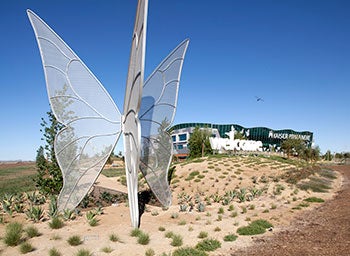California hospitals conserve water as drought drags on
 |
| Photo courtesy of Kaiser Permanente Kaiser Permanente Antelope Valley Medical Offices in Lancaster, Calif., uses native, drought-resistant plants to conserve water, a common strategy of drought-stricken California hospitals. |
While hospitals are largely exempt from California’s 25 percent water-reduction mandate that went into effect last year, some are making strong contributions to the state’s conservation efforts through a variety of strategies.
Stanford Health Care in Palo Alto began a number of water-reduction strategies years ago starting with a comprehensive water audit in 2009 conducted in partnership with its local utility and water district, says Krisanne Hanson, director of sustainability, Stanford University Medical Center.
Since then, it has installed more than 600 laminar-flow restrictors and 150 low-flow fixtures in patient care areas, reduced landscape watering and installed xeriscaping at some facilities, and decommissioned decorative outdoor water features. Stanford also has enlisted staff to report any leaking water faucets.
A major water-saving action involved replacement of steam sterilizers, and surgical instrument and cart-washing systems. The upgrade included installation of a closed-loop water system that recirculates condensate from the sterilizing process rather than cooling it before discharging it into the sewer system. The technology saves Stanford more than 12 million gallons of water annually, Hanson says.
Together, the conservation measures have reduced water use from 65.7 million gallons a year in 2010 to 40.4 million gallons annually in 2014, a reduction of 25.3 million gallons, or about 39 percent, Hanson says. That represents a savings of nearly half a million dollars in water expenses.
As a sustainability leader that also is admittedly a large water consumer, Kaiser Permanente, Oakland, stepped up its conservation efforts in 2014 and will continue taking aggressive actions going forward.
“We feel there is an environmental responsibility to conserve water,” says Scott Wendling, regional executive of support services and sustainable resource officer, Kaiser Permanente, Southern California region.
At some facilities, Kaiser has replaced in-ground sprinkler systems with drip irrigation, which uses 20 to 50 percent less water, and also installed weather-monitoring irrigation controls. It also is replacing turf with native and drought-resistant landscaping, and retrofitting faulty plumbing fixtures with low-flow and flow-control options.
The actions are paying dividends. Smart irrigation controllers that account for weather patterns and putting in native and drought-resistant plants have reduced water use for irrigation by 50 percent at Kaiser Permanente’s Woodland Hills Medical Center and 60 percent at its Panorama City Medical Center, Wendling says.
Conservation efforts have reduced the health care system’s water usage over the past two years by more than 960 million gallons, or 15 percent, for a nearly $1 million savings in 2015 even as the system has grown by 3.4 million square feet.
Likewise, Sutter Health, Sacramento, has taken a variety of water conservation steps across its network of 24 hospitals in northern California starting about five years ago.
“While Sutter Health hospitals and care centers use and need water to ensure a clean and safe environment, we’re determined to help reduce unnecessary water consumption,” says Karen Garner, Sutter Health spokesperson.
Sutter consolidated several laundry facilities into one LEED-certified plant, which uses high-efficiency equipment that saves 12 million gallons of water annually.
The network has reduced the frequency of pressure washing, installed drip irrigation for most new landscaping and replaced existing turf with drought-tolerant plants where possible.
Sutter’s California Pacific Medical Center in San Francisco installed low-flow plumbing fixtures and upgraded its cooling system, saving 18.7 million gallons of water annually, a 24 percent reduction.
The network’s Santa Rosa Regional Hospital diverts storm water from its roof to bioswales and catch basins on-site, allowing rainwater to infiltrate slowly into the soil. It is expected to cut water use by 50 percent.




